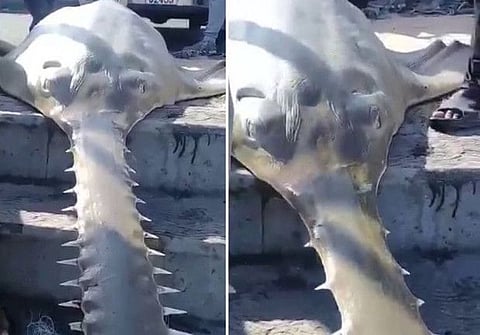Pakistan: Fisherman nets extremely rare sawfish in Jiwani
It was caught in bottom-set gillnet deployed for catching demersal fishes at the seaside

Also In This Package
Islamabad: A Pakistani fisherman caught extremely rare and critically endangered Longcomb Sawfish in the seaside town of Jiwani in Balochistan.
Hearing about the rare catch, Ghulam Nabi, a senior fisherman from Jiwani and a team from World Wildlife Fund (WWF)-Pakistan, visited the location to collect the necessary information. The fish was caught in a bottom-set gillnet deployed for catching demersal fishes at the seaside near Pakistan and Iran border on October 29.
Occurrences in Pakistan as recoded by WWF-Pakistan:
1. On September11, 2009, a 1.4-meter-long Pristis pristis landed at Gwadar Fish Harbour. 2. IN June 2013, a large specimen of sawfish was caught at Khajr Creek near the mouth of the River Indus. 3. One Largetooth Sawfish was landed at Karachi Fish harbour on 11 May 2015. 4. In January 2016, another Pristis pristis was entangled in the fishing net at Surbandar, Balochistan, making it the fourth such sawfish occurrence in Pakistan.
How is it recognised
“The sawfish is an extremely rare occurrence and it was caught after about 30 years in the area” WWF-Pakistan said in its statement. “In the past 10 years, only three authentic records of their occurrence in Pakistan have been recorded. The last authentic record of the occurrence of this species was reported on 30 May 2013 when a large Longcomb Sawfish (rostrum 113 cm) was caught by fishermen at Khajar Creek.”
A sawfish can be recognised by its saw-like long and narrow rostrum (nose extension) with a row of tooth-like scales on either side.
The main area of sawfish fishing in Pakistan was Miani Hor (Sonmiani), Kalmat Khor, Jiwani, Gwadar, Pakistan-Iranian border (Gwater Bay), and it was reported all along the Indus Delta, especially Khajar Creek, said Muhammad Moazzam Khan, marine fisheries’ technical advisor at WWF-Pakistan. “Sawfish meat used to be exported to Sri Lanka along with other sharks in salted dried form while its fins used to be exported to Hong Kong”, he added.
Sawfish is critically endangered
Longcomb Sawfish, also known as Green Sawfish, Narrowsnout Sawfish and Olive Sawfish, is the largest of all existing sawfishes. They were once found in the Indo-West Pacific oceans but have now disappeared from places they were once seen. International Union for Conservation of Nature (IUCN) listed all sawfish species as ‘Critically Endangered’.
“This species, scientifically known as Pristis zijsron, is considered to be extremely rare and faces the threat of extinction.” However, due to overfishing and habitat degradation, the population of sawfish has decreased substantially and they are now considered to be nearly extinct at the local level, the WWF said.
Sawfish in Pakistan
WWF-Pakistan has initiated a study on historical data on sawfish in Pakistan by interviewing retired fishermen. The study revealed that there used to be a large fishery of sawfish in Pakistan before 1970, however, their population declined by the 1980s, because of high mortality in fishing gears as their rostrums (saws) can easily become entangled in nets and other fishing gear. Sawfish have a long life, slow growth, late maturity, and low fecundity, making them extremely vulnerable to any changes that may reduce their population.
Sawfish are included in Appendix 1 of the Convention on International Trade in Endangered Species (CITES) which prohibits any commercial trade in those species. Both Sindh and Balochistan governments have enacted laws banning the catching, marking and sale of sawfish in the respective provinces.
Sign up for the Daily Briefing
Get the latest news and updates straight to your inbox









